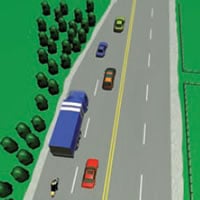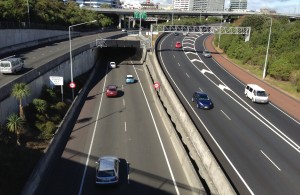New Zealand doesn’t have an extensive motorway network like, for example, the UK, but if you live in Auckland, Wellington, Christchurch or Dunedin then you might need to drive on them frequently, not including the few expressways in Tauranga, Waikato, Hawke’s Bay and extending from existing motorways.
Motorways present a number of driving situations that don’t occur frequently on single carriageway roads such as traffic merging at various speeds, vehicles overtaking on the left and the right, gantry signs and vehicles travelling at high speed next to one another. Let’s cover off four things you’ll need to consider when driving on the motorway.
Speed
Motorways are designed to efficiently move large numbers of vehicles at a similar speed across a long distance. ‘Similar speed’ is essential to a motorway functioning efficiently.
If you drive too slowly on the motorway you will cause lots of lane changes by motorists who will need to overtake you. Changing lanes on a motorway increases the risk of an accident and also slows the average speed once the traffic reaches a critical mass. Some traffic modelling algorithms will say that one driver making an erratic move can trigger a traffic jam – like a ‘butterfly effect’ of driving. Driving slowly will frustrate other drivers. If you or your vehicle cannot drive within 20kph of the motorway speed limit then you are causing a problem.
Fast drivers are equally to blame. Because all traffic tends to move at a similar speed, drivers may not be able to predict the position of your vehicle if you are travelling much faster than everyone else. This can cause them to pull out in front of you which might cause an accident. It also means that you are less able to avoid situations such as traffic suddenly stopping, and therefore you increase your risk of having an accident.
Fast drivers can also intimidate slower drivers causing them to drive even more slowly or nervously.
Keeping your distance
When you tailgate another vehicle you reduce the gap between you and it and therefore variances in the speed of the vehicle ahead of you will seem magnified because they will change the gap proportionally more. For example, if you are travelling 50m behind a car in front and its speed drops enough so that the gap closes by 5m to 45m, that’s a change of 10%; if you are travelling 20m behind a car in front and the same 5m change occurs, that’s a 25% change in the relative distance, and that is likely to cause you to brake.
When you brake, your brake lights come on and this signals to drivers behind that they should prepare to brake, too. Many will brake whether they need to or not, and almost all will lift off the accelerator. The effect of this above a certain traffic density is to cause traffic to slow down.
The other effect is that you will wear your brakes out more quickly.
You should also never travel with your foot resting on the brake pedal. You are not driving a go-kart. Your brake lights come on as soon as the brake pedal starts to move – that’s before you feel any braking effort. People behind you, though, won’t be able to tell if you are braking or not and if you do need to brake suddenly you risk someone running into the back of your vehicle.
Keeping your distance – following the two-second rule in the dry and the four-second rule in the wet (or if you are towing a trailer) – is the best option to reduce your chances of having a nose-to-tail accident, and it also leaves room for other drivers to safely move into your lane if they need to. This video shows you how easily you can run into the back of someone. At the beginning of the video, the driver is following the Suzuki Swift about 1.5-2 seconds behind. As the Swift brakes, the driver doesn’t maintain the gap, letting it fall to between 0.5-1 second. Eventually, the Swift stops abruptly and the driver doesn’t have enough time to react. The second mistake the driver made was to choose to steer towards traffic coming from the other direction, rather than head for the side of the road. This could have caused a much more serious head-on crash.
Merging from on-ramps
 Chances are that the on-ramp you are driving down has its origins in a 50kph road, and the motorway is a 100kph road. As soon as you get on that on-ramp it is your job to increase your speed to match that of the vehicles on the motorway. It is extremely dangerous to try to merge onto the motorway at 50kph when traffic is doing 90-100kph.
Chances are that the on-ramp you are driving down has its origins in a 50kph road, and the motorway is a 100kph road. As soon as you get on that on-ramp it is your job to increase your speed to match that of the vehicles on the motorway. It is extremely dangerous to try to merge onto the motorway at 50kph when traffic is doing 90-100kph.
Merging at a speed that is too low causes other drivers to brake and we’ve seen above what happens then. A chain of braking occurs backwards down the motorway as cars have to slow down.
Merge like a zip on an on-ramp. Match your speed to that of the vehicles already on the motorway, pick a space between two of the vehicles and indicate your intention to move into that space. If you hesitate then you create uncertainty in other drivers and they will change their speed or lane and that causes consequences as we’ve mentioned above.
It is your job as a driver not to disrupt traffic flow.
Merging from the hard shoulder
If you’ve had to pull over to deal with an issue in your car such as re-securing a load or changing a flat tyre then you’ll need to merge back onto the motorway. The hard shoulder can be used to get back up to the same speed as traffic on the motorway before merging into the lanes. When traffic is heavy and slow, this will be fairly easy; when traffic is faster then you’ll need to watch more carefully. Once you’re up-to-speed, begin to indicate your intention to move onto the main motorway carriageway (i.e. the left-hand lane). The edge of the motorway might have a prominent lip which can throw your vehicle off-line slightly as you change lanes. Choose your gap, check your blind spot and, if everything’s clear, move into it.
Changing lanes
 As we’ve discussed above, lane changes also cause traffic to change its speed. Unless you are exiting a right-lane off-ramp like you’re heading to the port when driving on Auckland’s Northwestern Motorway towards the city, you should only be changing lanes to the right for overtaking another vehicle. Driving in the middle lane when you are not overtaking is not good driving. In the UK, police prosecute drivers for this, so you can expect that it will come to New Zealand sometime soon.
As we’ve discussed above, lane changes also cause traffic to change its speed. Unless you are exiting a right-lane off-ramp like you’re heading to the port when driving on Auckland’s Northwestern Motorway towards the city, you should only be changing lanes to the right for overtaking another vehicle. Driving in the middle lane when you are not overtaking is not good driving. In the UK, police prosecute drivers for this, so you can expect that it will come to New Zealand sometime soon.
When you change lanes, adjust your speed to match the speed in that lane as you indicate and make the manoeuvre. Of course, you will have checked that there is room for you to move, too. The same is required when you change lanes to your left. Check the mirrors, signal, make the manoeuvre and brake to match the speed (assuming the lane on the left is travelling slower).

